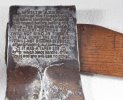I'm in the believer of High centerlines camp.
 Hickory n steel
Hickory n steel
add the Council Tools hatchet to the list of currently produced axes with high centerlines. They work for me and my uses which involve bucking, limbing, and Splitting. This past weekend I ended up using an old Bingham's XLCR hatchet on a long handle over my Gransfors SFA. It just simply put did a better job for the tasks at hand. I attribute that to the high centerline, but also the longer and thinner handle.
As for the discussion of when high centerlines came about. The axes Bernie posted up from the 1700s both had high centerlines. I would say they have been in use for a reasonable amount of time.

 XLCR Camp Axe
XLCR Camp Axe High Centerline Action
High Centerline Action Belt Axe Top
Belt Axe Top Belt Axe Bit Profile
Belt Axe Bit Profile Belt Axe side A
Belt Axe side A


